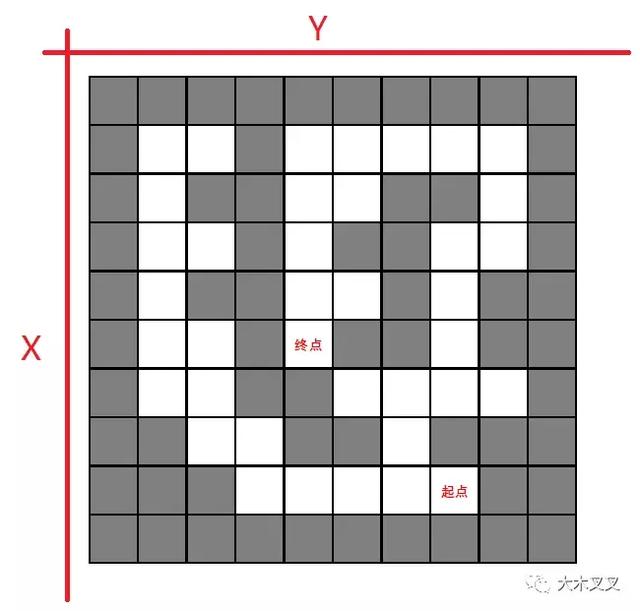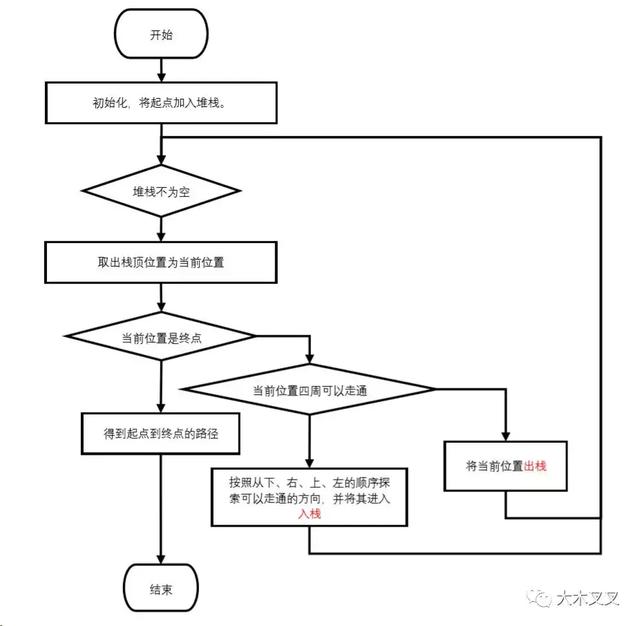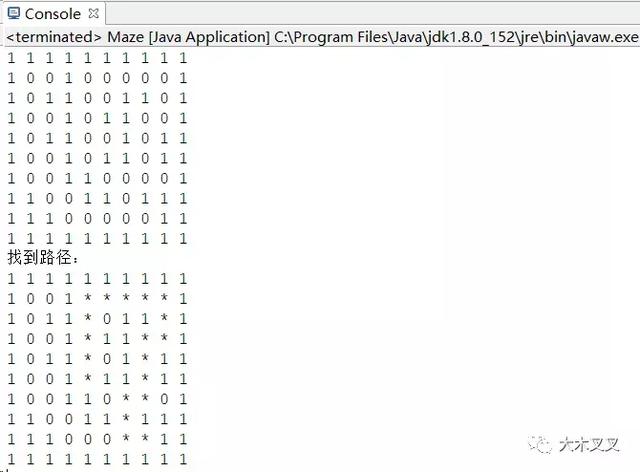1.栈模型
栈(stack)是限制插入和删除只能在一个位置上进行的表,该位置是表的末端,叫作栈的顶(top)。对栈的基本操作有push(进栈)和pop(出栈),前者相当于插入,后者则是删除最后插入的元素。
栈有时候也被叫作LIFO(后进先出)表,只有栈顶元素是可访问的。栈模型如图1.所示。

图1.栈模型
2.栈的实现
由于栈是一个表,因此任何实现表的方法都能实现栈,ArrayList和LinkedList 都能够支持栈的操作。我们以前的一篇文章《用 java 编程实现链表》中构造的双向链表来实现栈的功能。通过在顶端传入实现push,通过删除表顶端元素实现pop,peek操作考察表顶端元素并返回它的数值。在此我们使用源码包java.util.Stack的Stack类,测试代码为:
package SatckPackage;
import java.util.Stack;
public class StackTest {
public static void main(String[] args){
Stack<String> stack = new Stack<String>();
stack.clear();
stack.push("First");
stack.push("Second");
stack.push("Third");
System.out.println(stack.size());
System.out.println(stack.peek());
stack.pop();
stack.pop();
System.out.println(stack.size());
System.out.println(stack.peek());
}
}
栈的构造方法比较简单,在此不做详细讲解,输出结果为:

图2.输出结果图
3.栈的应用——迷宫求解问题
求迷宫从入口到出口的所有路径是一个经典的程序设计问题[1]。由于计算机解迷宫时,通常用的是“穷举求解”的方法,即从入口出发,顺某一方向向前探索,若能走通,则继续往前走;否则沿原路退回,换一个方向再继续探索,直至所有可能的通路都探索到为止。
为了保证在任何位置都能沿原路退回,显然需要用一个后进先出的结构来保存从入口到当前位置的路径。因此在迷宫求解时应用“栈”也就是自然而然的事情了。在计算机中,我们可以用一个二维数组来表示一个迷宫,如下图所示:

图3.迷宫图

图4.迷宫模型图
我们使用字符1来表示迷宫中的墙体,即灰色的方块;使用字符0来表示可以通过的道路,即白色的方块。求解迷宫的 算法 思想可以描述为下图的流程图:

图5.求解迷宫流程图
3.1. 代表地图上方格的cell 类
package SatckPackage;
/**
* 迷宫通道类,一个Cell代表地图上的一个方块
*/public class Cell {
private int x; // 单元所在行
private int y; // 单元所在列
private char c; // 字符,通道对应'0',墙对应'1'
private boolean isVisited;// 是否访问过
public Cell(int x, int y, char c, boolean isVisited) {
super();
this.x = x;
this.y = y;
this.c = c;
this.isVisited = isVisited;
}
public char getC() {
return c;
}
public void setC(char c) {
this.c = c;
}
public boolean isVisited() {
return isVisited;
}
public void setVisited(boolean isVisited) {
this.isVisited = isVisited;
}
public int getX() {
return x;
}
public int getY() {
return y;
}
public boolean equals(Object obj) {
if (this == obj)
return true;
if (obj == null)
return false;
if (getClass() != obj.getClass())
return false;
Cell other = (Cell) obj;
if (x != other.x)
return false;
if (y != other.y)
return false;
return true;
}
public String toString() {
return this.getC() + "("+this.getX()+", "+this.getY() + ")";
}
}
3.2.求解迷宫的主方法
package SatckPackage;
import java.util.Stack;
/**
* 迷宫求解类
*/public class Maze {
public static void main(String[] args) {
char maze[][] = { { '1', '1', '1', '1', '1', '1', '1', '1', '1', '1' },
{ '1', '0', '0', '1', '0', '0', '0', '0', '0', '1' },
{ '1', '0', '1', '1', '0', '0', '1', '1', '0', '1' },
{ '1', '0', '0', '1', '0', '1', '1', '0', '0', '1' },
{ '1', '0', '1', '1', '0', '0', '1', '0', '1', '1' },
{ '1', '0', '0', '1', '0', '1', '1', '0', '1', '1' },
{ '1', '0', '0', '1', '1', '0', '0', '0', '0', '1' },
{ '1', '1', '0', '0', '1', '1', '0', '1', '1', '1' },
{ '1', '1', '1', '0', '0', '0', '0', '0', '1', '1' },
{ '1', '1', '1', '1', '1', '1', '1', '1', '1', '1' }};
mazeExit(maze, 8, 7, 5, 4);
}
/**
* 求解迷宫
* @param maze 迷宫的字符数组
* @param in_x 起点x坐标
* @param in_y 起点y坐标
* @param out_x 终点x坐标
* @param out_y 终点y坐标
*/ public static void mazeExit( char maze[][], int in_x, int in_y, int out_x, int out_y) {
Cell[][] cells = createMaze(maze);
printMaze(cells);
Cell start = cells[in_x][in_y];
Cell end = cells[out_x][out_y];
Stack<Cell> stack = new Stack<>();
stack.clear();
stack.push(start);
start.setVisited(true);
while (!stack.isEmpty()) {
Cell now = stack.peek();
if (now.equals(end)) {
// 找到路径
int x = out_x;
int y = out_y;
while(!stack.isEmpty()){
Cell cell = stack.pop();
// 要注意的是,只有和上一次的cell相邻的cell才是路径上的通道
if(Math.abs(cell.getX()-x) + Math.abs(cell.getY()- y) <= 1){
cell.setC('*');
}
x = cell.getX();
y = cell.getY();
}
System.out.println("找到路径:");
printMaze(cells);
return;
} else {
// 向四个方向探索
boolean isDead = true;
for (int i = 0; i < 4; i++) {
Cell next_cell = getCell(cells, now, i);
if (isValid(next_cell)) {
next_cell.setVisited(true);
stack.push(next_cell);
isDead = false;
}
}
// 四个方向都不能走,则该点为死胡同,出栈
if(isDead){
stack.pop();
}
}
}
System.out.println("找不到路径");
}
/**
* 判断一个cell是否是通道
*/ public static boolean isValid(Cell cell) {
return cell.getC() == '0' && !cell.isVisited();
}
/**
* 根据方向得到下一个cell
*/ public static Cell getCell(Cell[][] cells, Cell now, int direction) {
int x = now.getX();
int y = now.getY();
Cell cell = null;
switch (direction) {
case 0:
// 向下
cell = cells[x + 1][y];
break ;
case 1:
// 向右
cell = cells[x][y + 1];
break;
case 2:
// 向上
cell = cells[x - 1][y];
break;
case 3:
// 向左
cell = cells[x][y - 1];
break;
}
return cell;
}
/**
* 根据输入的二维char数组创建二维Cell数组
*/ private static Cell[][] createMaze(char[][] maze) {
Cell[][] cells = new Cell[maze. length ][maze[0].length];
for (int i = 0; i < maze.length; i++) {
for (int j = 0; j < maze[i].length; j++) {
char c = maze[i][j];
Cell cell = new Cell(i, j, c, false);
cells[i][j] = cell;
}
}
return cells;
}
/**
* 打印迷宫
*/ private static void printMaze(Cell[][] cells) {
for (int i = 0; i < cells.length; i++) {
for (int j = 0; j < cells[i].length; j++) {
System.out.print(cells[i][j].getC() + " ");
}
System.out.println();
}
}
}
输出结果为:

图6.输出结果图
分析上述算法我们可以在下面代码处打上断电来观察输出结果:
while (!stack.isEmpty()) {
Cell now = stack.peek();
System.out.println("X="+now.getX());
System.out.println("Y="+now.getY());
System.out.println("---------------");
···························}

图7.算法轨迹
(红色箭头表示push(),蓝色箭头表示pop())
图7.给出了算法在各个步骤所走过的方格位置,其中红色箭头表示push(),蓝色箭头表示pop(),可以看出算法从起点开始,通过遍历完所有的途径,直到找到一条到达终点的轨迹为止。
[1]



